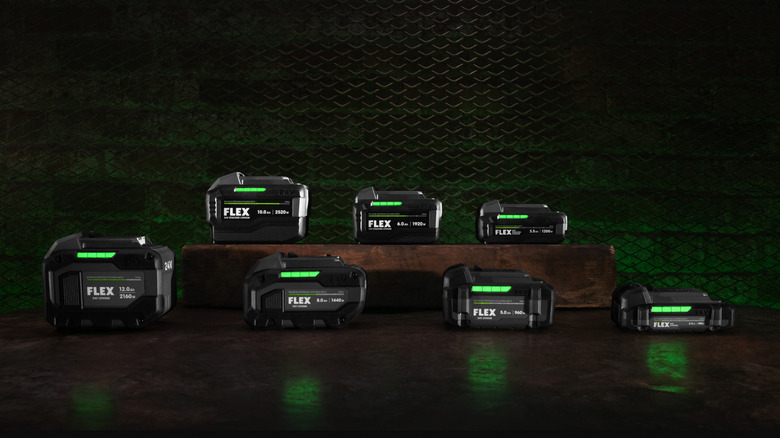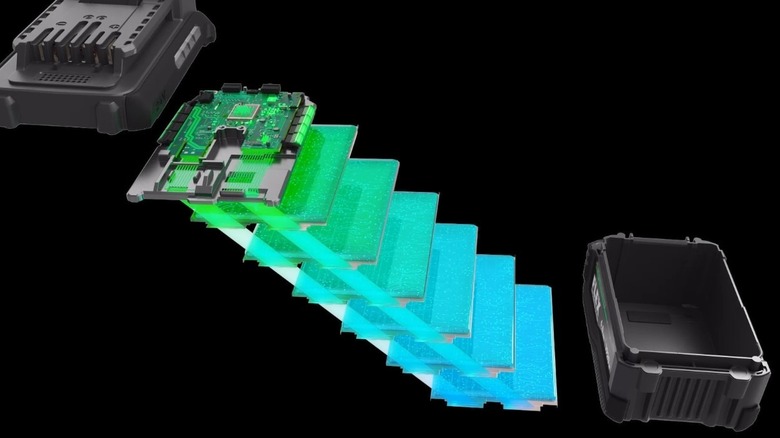Flex Has Stacked Lithium Power Tool Batteries - Here's What That Means
While every major power tool brand has its own proprietary battery system to power tools and accessories, the general concept of a rechargeable power tool battery is more or less consistent among them. You have a small array of power cells, usually made of lithium, paired with internal circuitry that communicates directly with a connected tool to optimize power flow and delivery. All of this is packed up into a solid case, then clipped onto a tool's receiver via connector rails. The batteries employed by hardware brand Flex follow this same basic concept, but with one critical difference: stacked lithium.
Rather than the usual array of power cells, Flex's 24V Stacked Lithium Batteries utilize multiple layers of lithium cells sandwiched on top of one another in a tight stack. This particular design choice is intended to increase the overall power output capacity of the battery, increasing its performance to 200% that of most leading rechargeable battery systems, at least by Flex's reckoning. In addition to output, Flex's batteries are designed to hold more energy than their contemporaries, as well as recharge faster with the help of a Flex Super Charger.
Multiple layers of lithium cells allow the packs to output more power
The main technology behind Flex's 24V Stacked Lithium Batteries is the titular stacked lithium power cells. If you look inside a battery from one of the other major hardware brands like Ryobi, Milwaukee, or DeWalt, you'll usually find a small array of cylindrical power cells, similar in shape to regular disposable batteries. This is where the actual power is stored and delivered, as well as regulated by the internal circuitry. Flex's Stacked Lithium Batteries, meanwhile, use a power storage format more akin to an AGM car battery's internal plates, with multiple layers of long, flat lithium cells stacked up and sandwiched together, then topped off with Flex's own Power IQ intelligent battery processor. In addition to the cells, a Flex battery is also equipped with Flex's Therma-Tech heat management system, which makes use of a proprietary phase-change material that safely absorbs and dissipates ambient heat from the cells.
The higher concentration of lithium cells in this particular format allows the battery to store and deliver a greater quantity of electricity than a battery with the traditional cell array, while the heat reduction system allows the battery to safely push itself harder without burning out. According to Flex's statistics, these systems allow a battery pack with a lower Ah to deliver comparable or more energy than larger batteries from the major brands. A 3.5Ah Flex battery has comparable power to 8Ah batteries from Milwaukee and DeWalt, a 6Ah Flex battery slightly outpaces 12Ah batteries from Milwaukee and DeWalt, and a 10Ah battery significantly outperforms those same 12Ah batteries.
Flex Stacked Lithium batteries are designed to last longer and charge faster
In addition to delivering a higher concentration of power, Flex also advertises its Stacked Lithium Batteries as being both longer-lasting and faster-charging. According to Flex, a 24V Stacked Lithium battery has a total power capacity of up to 300% more than comparable traditional lithium power tool batteries, which you can check via the meter on the side of the battery's casing.
Flex also advertises that the Stacked Lithium Batteries can be recharged 100% faster than similar power tool batteries. Besides the battery's own internal technologies, this is facilitated largely by Flex's companion line of high-speed battery chargers. For example, the Flex Super Charger, which is optimized for use with Stacked Lithium Batteries, can fully recharge a 3.5Ah Stacked Lithium Battery in about 15 minutes. Even the highest-power 10Ah battery would only take around 30 minutes to fully juice up. Flex batteries are also compatible with all other accessories within the Flex 24V system, including the other chargers like the Fast Charger and Rapid Charger. However, these chargers are not optimized for Stacked Lithium, so their charge times may not be as impressive.


